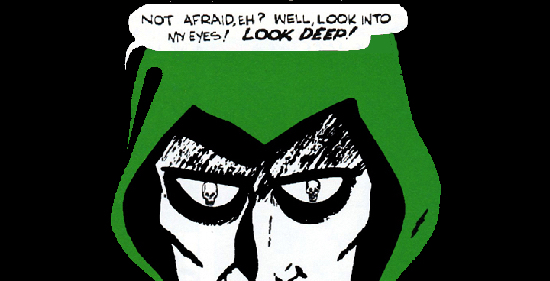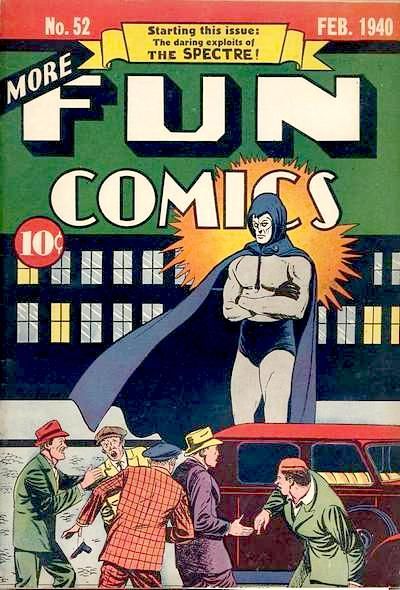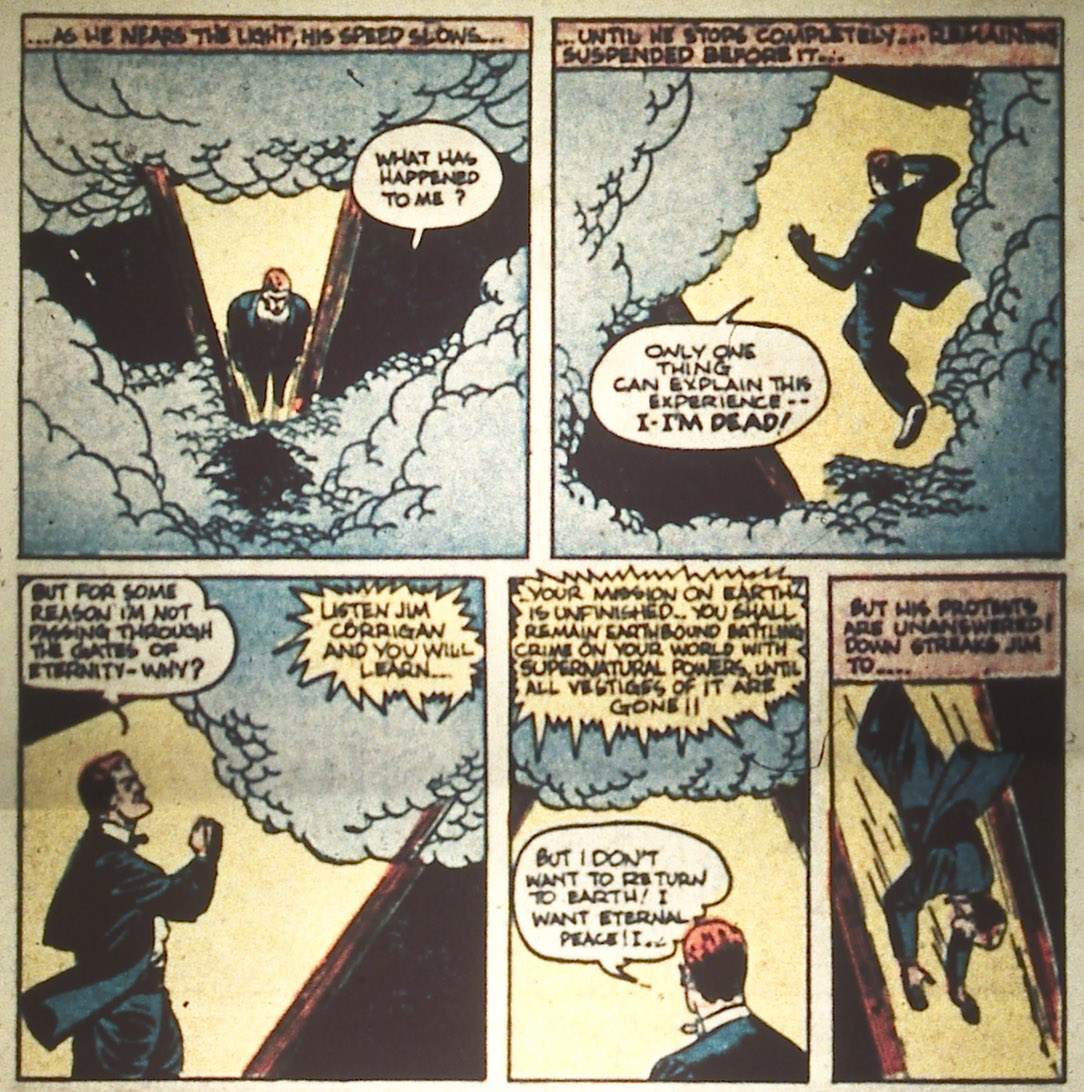Peer into the Eyes of The Spectre - Golden Age Reviews
Jan 7, 2020 23:19:06 GMT -5
shaxper, MWGallaher, and 13 more like this
Post by chadwilliam on Jan 7, 2020 23:19:06 GMT -5

Having recently read through my Golden Age Spectre Archives containing his first 19 adventures in More Fun Comics and having wanted to contribute my own review thread somewhere on these boards eventually, I figured The Spectre is the way to go. His fifty appearances in More Fun starting with issue 52 and ending in 101 and his 23 showings in All-Star Comics would seem to make this a manageable feat and the fact that these appearances begin when superhero comics were in a nascent form and end, well, once they had settled into a form which they probably shouldn't have shaped themselves into, makes this an interesting prospect. What do I mean by that last remark? Well, it's sort of why I qualified the statement that this is a manageable feat with the word "seem". Here's the thing about The Spectre - he's one of the Golden Age greats (probably because he was invented by one - Jerry Siegel) and there's an originality to the character, to the stories, and even a sense of 'Fun' about him despite the fact that 'Morbid Fun' might be a more a suitable title to house his adventures than the whimsical sounding 'More Fun' - but... and it's a big BUT...
...I don't know how much of Percival Popp I can take. Who is Percival Popp? Thankfully, no one right now. Right now, The Spectre works alone and his very existence is a better guarded secret than all of those secret identities superheroes had which were usually only known by "one or two people" (or less). But come More Fun Comics 74, he becomes The Spectre's comic sidekick. Yes, The Spectre - merciless bringer of death, vengeful agent of God - had a comic sidekick for about two dozen issues and I don't know how many of those I can take. So what I'm saying is this: I'm going to start this thread and I'm going to keep at it all through those first 20 or so More Fun appearances and whichever issues of All-Star which corresponds with those, but I don't know how I'm going to handle Percival Popp, The Super-Cop. I mean to see this thread through to the end, but man, if those reviews sound like I'm just slamming my fists into my keyboard trying to punch out whichever obscenities "Popp" into my head the fastest, it'll probably be because I am. So... no promises on where things will go.
But that's still in the future. Right now, we're going to concern ourselves with...
More Fun Comics #52 (February 1940)
“The Spectre”
Writer: Jerry Siegel
Artist: Bernard Baily

Synopsis: A decidedly unexpected status quo is established for Jim Corrigan at the start of his origin story and it really is Jim Corrigan’s tale for The Spectre is almost nowhere to be seen in this, his debut appearance. So what is that status quo? A boarding house; a roommate friend/fellow detective named Wayne Grant with whom Corrigan shares a sort of goof-ball relationship (we see him dunking Grant’s head in a sink for joking about his upcoming marriage); an upcoming wedding for Corrigan with a young socialite who we can already tell is a league above the uncouth detective’s – Clarice Winston.
After a bit of exposition setting all of this up, we get something which better resembles the type of story you’d expect from a hardboiled detective such as Jim Corrigan when a stool pigeon stops by his place with a tip about a planned robbery of a fur warehouse. Although the interruption comes at a lousy time for Corrigan who is expected at a party held by his fiancé, the tip pays off. Single handedly taking down four of “Gat” Benson’s men, the detective is tracked down by Clarice to The Lakeside Hospital though it’s hard to tell just what injuries he could have sustained given how effectively he manhandled Benson’s gang. ‘Tough’ is putting mildly how one would describe our star feature.
Unfortunately, the pair are followed from the hospital by Benson who intends to finish his foe off once and for all. Stopping the car briefly to explain to his wife just what type of man she intends to marry proves a costly mistake for Corrigan when Benson uses this opportunity to hold him up and force him into his own vehicle at gunpoint. While a bad move for Corrigan, it does enlighten us as to his character if we haven’t already made up our minds.
“It’s high time I told you a thing or two”, Corrigan declares. “Why a real lady like you should be interested in a mug like me is beyond me, but one thing is certain: There’s going to be one boss in our family and that’s me!”
The words make Clarice swoon and they embrace.
OK, so “Gat” Benson and his men have Corrigan and his fiancée. What happens next? The couple are taken for a ride with Corrigan taking advantage of every moment to tell Benson that he thinks he’s a rat whose face would be on the receiving end of his fist given the first opportunity. Arriving at waterfront warehouse, Corrigan is placed into a barrel which is then filled with cement and chucked into the river. One can only hope that the blow Corrigan received on the head just before being placed in this predicament kept him unconscious during his final moments for as one of the gang remarks, “G-Gosh! Wotta way to die!”
Here's where things get really interesting.
Corrigan finds himself rising to the surface freed from the constraints of the barrel and towards a patch of light. His journey stops midway however when a voice informs him that “your mission on Earth is unfinished… you shall remain Earthbound battling crime on your world with supernatural powers until all vestiges of it are gone!!”

These plans don’t sit well with Corrigan who wishes to find eternal peace, but the matter is decided and Corrigan is sent back to the bottom of the river. No problem though, for he is no longer capable of drowning. The sight of his own hand protruding from the barrel perturbs him and Corrigan declares vengeance upon Benson and his men. Rising to the surface, the detective discovers that merely by willing it, he can fly and make himself invisible. A scream intrudes upon his thoughts which Corrigan recognizes as Clarice’s. He heads back to the wharf, walks through a wall, and there the story ends with a promise to continue next issue.
Thoughts: Jim Corrigan wouldn’t be my first choice for a character to headline a series entitled ‘More Fun’ given his personality. Though I might be too far removed from the era to judge accurately just how Corrigan would have been perceived by his 1940 audience, his personality is more James Cagney than, say, Dick Tracy or Bulldog Drummond. I have no problem with him getting tough with a stool pigeon or “Gat” Benson, but man, this guy doesn’t change his tone with anyone. A friend teases him about marrying above his station and Corrigan shoves his head in the sink and turns on the tap; his fiancée reprimands him for missing a party and he gives her that whole “I’m the boss” speech; one even has to wonder how that stoolie benefits from his relationship with Corrigan when he asks what he’ll get for his tip and the detective responds “The tip of my foot!”. If anyone would welcome the chance to become the all-powerful, vengeful Spectre, it should be Jim Corrigan – his plea to The Voice for “eternal peace” seems a little hollow.
But then again, just who is The Spectre? Aside from the cover and splash page (depicting a scene which would have to take place after this issue) he doesn’t exist yet. That splash does provide us with the following information:
“The “Spectre”, a supernatural being, whose mission on Earth is to stamp out crime and enforce justice with the aid of such weird powers as becoming invisible, walking thru walls and delivering death with a glance”.
That splash also depicts him as roughly 15 feet tall so along with the “death with a glance” power, we’re being teased with two attributes which won’t be displayed until some future adventure. In this issue, Corrigan’s abilities are thus far limited to invisibility, walking through walls, flying, and being able to survive at the bottom of the river without drowning (well, at least on his second try).


Not too long ago, Shaxper made a persuasive argument that Wolverine’s so-called first appearance in Hulk 181 is more a cameo than actual appearance. I think a similar argument could be made for this issue if one were so inclined, but to me, the lack of The Spectre is more an odd detail about this comic than an important enough feature to really do more with than raise an eyebrow and move on.
Jerry Bails, in his foreword to The Golden Age Spectre Archives Vol.1, contextualizes the prominent role the character had in DC’s early history. Superman and Batman were hits; The Crimson Avenger and Sandman were around, but hardly big names; The Flash and Hawkman? Well, those guys were property of All-American and hadn’t yet joined National Periodicals (DC). Beyond Action Comics and Detective Comics, DC had only two other major titles – More Fun and Adventure. So really, DC had only about a handful of superheroes in its stable and with Marvel having introduced The Submariner, Angel, and The Human Torch at the end of 1939, and other heroes popping up here and there through other publishers, DC had to do something to reinforce its top position within the industry. The Spectre (along with Hourman, also penciled by Spectre illustrator Bernard Baily for Adventure) was one of those somethings.
It made sense for DC to turn to Jerry Siegel for a new idea given the fact that he had already given them Superman. Unfortunately, while much has been documented about the origins of Superman, I can find little on The Spectre. Now, that doesn’t mean people haven’t theorized. In recent years, some attention has been paid to the death of Siegel’s father, Michel Siegel. In 1932, the elder Siegel ran a clothing store and died during a robbery. Claims that he died from a gunshot are untrue – Siegel died of a heart attack during the event – and while this may very well have influenced Siegel’s creation of Superman and The Spectre there’s no evidence which I’m aware of to support this. I mention this fact only to explain my reasoning for not bringing it up further – I don’t know of Siegel going into detail about the origins of The Spectre just as I don’t know of anyone even mentioning the tragic death of his father prior to Brad Ricca and shortly thereafter Marc Nobleman uncovering this information a little over ten years ago (Jerry Siegel died in 1996). It’s very tempting to suggest that this event triggered something in Siegel’s psyche and his writing, but without evidence, it’s all just speculation.
But what of the story itself?
With ten pages to make their case for this new character, Siegel and Baily are clearly determined to make The Spectre (well, Jim Corrigan anyway) work. As such, they use most every panel they can to excite, intrigue, or engage the reader. I think that what makes this work so well is Siegel’s familiarity with the newspaper comic strip to make it his template for telling a story. One of the great strengths of the Golden Age is that while it was a new medium initiating a new type of mythology, writers and artists had already been conditioned to not only copy the rapid fire pace of the newspaper strip, but aspire towards it. For this reason, you can almost guarantee that opening to any page in this story will ensure that you’ll be hit with a panel with a danger being established in one panel, the hero leaping into it in the next, and outcome in the third. It’s a sensible formula for a three paneled newspaper strip and it’s repeated again and again throughout this tale. With the danger and intrigue shifting from Corrigan taking down a gang of thugs to being chucked in a barrel and tossed into a river and then being given the chance to avenge his own death, there’s not a dull moment to be found.
There are chilling moments; Corrigan spots his hand reaching out of the barrel in which his corpse seems destined to remain when he’s returned by The Voice to the river bottom. Bizarre bits; I still can’t get over Corrigan threatening to dunk his roommate’s head in the sink in one panel as what seems to be just a jokey threat only for him to carry out the promise in the next – it sort of reminds me of the literal-minded punishments The Spectre will later dole out to his enemies. And despite the fast-pace of the tale, Siegel and Baily take their time here and there as well if they want to establish some little detail about their new character. Corrigan floating above the river and watching his shadow appear and disappear from one panel to the next as he discovers that he can turn invisible is a nice moment (though far from proving he can turn himself invisible at will, it just looks like the detective can make his shadow turn on and off from the way the scene is depicted.
Oh, and Corrigan can fly. Given the fact that at this point in time Superman is still at least a month away from progressing from leaping to flying on his radio show (he’ll have to wait even longer to prove capable of that feat in the comics) I wonder if The Spectre is the first DC superhero who can fly.
And man, “you shall remain earthbound battling crime on your world with supernatural powers until all vestiges of it are gone!” is one hell of a responsibility and set-up for further adventures.
And it all starts here…













